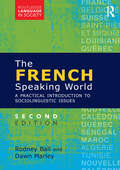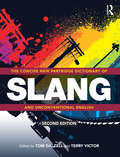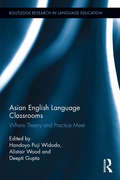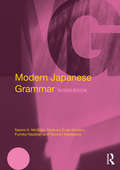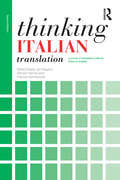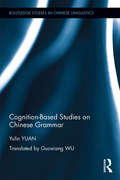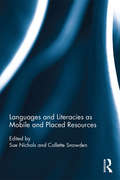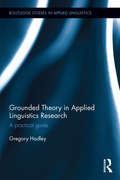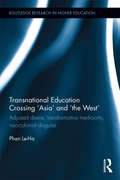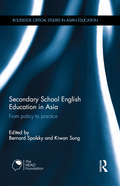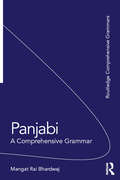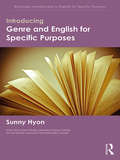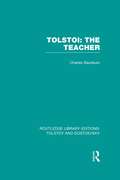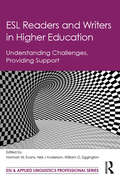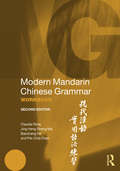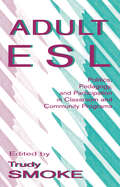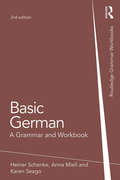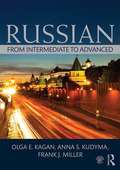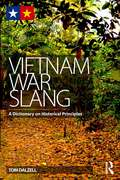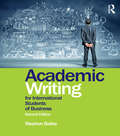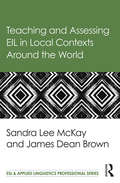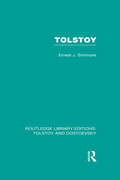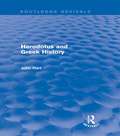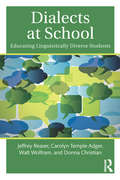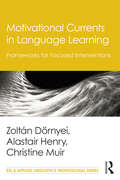- Table View
- List View
The French-Speaking World: A Practical Introduction to Sociolinguistic Issues (Routledge Language in Society)
by Rodney Ball Dawn MarleyThe French-Speaking World is an accessible textbook that offers students the opportunity to explore for themselves a wide range of sociolinguistic issues relating to the French language and its role in the world. This new edition has been fully revised to reflect the many political and social changes of the last 15 years, including the impact of technology on language change. It continues to combine text with practical exercises and discussion questions to stimulate readers to think for themselves and to tackle specific problems. Key features of this book: Informative and comprehensive: covers a wide range of current issues Practical: contains a variety of graded exercises and tasks plus an index of terms Topical and contemporary: deals with current situations and provides up-to-date illustrative material Thought-provoking: encourages students to reflect and research for themselves The French-Speaking World is the ideal textbook for undergraduate students who have a sound practical knowledge of French but who have little or no knowledge of linguistics or sociolinguistics.
The Concise New Partridge Dictionary of Slang and Unconventional English
by Tom Dalzell Terry VictorThe Concise New Partridge Dictionary of Slang and Unconventional English presents all the slang terms from The New Partridge Dictionary of Slang and Unconventional English in a single volume. Containing over 60,000 entries, this concise new edition of the authoritative work details the slang and unconventional English of from around the English-speaking world since 1945, and through the first decade of the new millennium, with the same thorough, intense, and lively scholarship that characterized Partridge’s own work. Unique, exciting and, at times, hilariously shocking, key features include: unprecedented coverage of World English, with equal prominence given to American and British English slang, and entries included from Australia, New Zealand, Canada, India, South Africa, Ireland, and the Caribbean emphasis on post-World War II slang and unconventional English dating information for each headword in the tradition of Partridge, commentary on the term’s origins and meaning. New to this second edition: a new preface noting slang trends of the last eight years over 1,000 new entries from the US, UK and Australia, reflecting important developments in language and culture new terms from the language of social networking from a range of digital communities including texting, blogs, Facebook, Twitter and online forums many entries now revised to include new dating and new glosses, ensuring maximum accuracy of content. The Concise New Partridge Dictionary of Slang and Unconventional English is a spectacular resource infused with humour and learning – it’s rude, it’s delightful, and it’s a prize for anyone with a love of language.
Asian English Language Classrooms: Where Theory and Practice Meet (Routledge Research in Language Education)
by Handoyo Puji Widodo Alistair Wood Deepti GuptaThe teaching of English in the Asian context is always challenging and dynamic because both teachers and learners have diverse linguistic and cultural backgrounds. Equally important, where English is not widely used outside the classroom, English language classrooms are an authentic site of learner engagement. For these reasons, for all those concerned with contemporary English language teaching (ELT) in Asia, Asian English Language Classrooms: Where Theory and Practice Meet, provides an account of theoretical orientations and practices in the teaching of English to multilingual speakers whose primary language is not English. While covering the fundamental ELT areas (e.g., the teaching of language skills, educational literature, the use of technology in ELT, the role of pragmatics in ELT, social psychology of the language classroom, and language classroom management) with which every language teacher and teacher trainer must be concerned, this volume showcases how particular orientations shape ELT practices. We believe that practicing English teachers must have a heightened awareness of the theory behind their practice. At the same time, the theoretical stance must be firmly anchored in actual classrooms. Containing newly commissioned chapters written by well-regarded and emerging scholars, this book will appeal not only to beginning teachers or teachers in training but also to established teachers around Asia where English is used as a lingua franca. If you are a student teacher of English or an English teacher who would like to see what other progressive teachers like you are doing across Asia, this is the book you have been looking for.
Modern Japanese Grammar Workbook (Modern Grammar Workbooks)
by Naomi McGloin M. Endo Hudson Fumiko Nazikian Tomomi KakegawaThe Modern Japanese Grammar Workbook is an innovative book of exercises and language tasks for all learners of Japanese. The book is divided into two parts: Section A provides exercises based on essential grammatical structures Section B practises everyday functions (e.g. making introductions, apologizing, expressing needs). All sentences are written both in Romanization and in the Japanese script and a comprehensive answer key at the back enables the learner to check on their progress. Key features of the book include: Exercises graded on a 3-point scale according to their level of difficulty Cross-referencing to the related Modern Japanese Grammar Topical exercises drawn from realistic scenarios to help learners develop their vocabulary and practical communication skills Opportunities to practise both written and spoken Japanese. Modern Japanese Grammar Workbook is an ideal practice tool for learners of Japanese at all levels. No prior knowledge of grammatical terminology is assumed and it can be used both independently and alongside the Modern Japanese Grammar (ISBN 978-0-415-57201-9), which is also published by Routledge.
Thinking Italian Translation: A course in translation method: Italian to English (Thinking Translation)
by Stella Cragie Ian Higgins Sándor Hervey Patrizia GambarottaThinking Italian Translation is an indispensable course for students who want to develop their Italian to English translation skills. This new edition includes: up-to-date examples and new source texts from a variety of genres, from journalistic to technical. a brand new section on professionalism and the translation market The course is practical, addressing key issues for translators such as cultural differences, genre, and revision and editing. At the same time, it clearly defines translation theories. Thinking Italian Translation is key reading for advanced students wishing to perfect their language skills or considering a career in translation.
Cognition-Based Studies on Chinese Grammar (Routledge Studies in Chinese Linguistics)
by Yulin YuanIntroducing the English translations of 8 selected research articles originally written in Chinese by Professor Yuan Yulin, Cognition-based Studies on Chinese Grammar is an essential reading for researchers in Chinese syntax. Yuan Yulin is one of the very first Chinese scholars who introduced cognitive sciences into the study of Chinese language some twenty years ago, and his work is well-known and highly regarded in China for its originality and theoretical contribution. The collection covers the core of his engagement with Chinese language studies, ranging from lexical exploration to grammatical discussion. Cognition-based Studies on Chinese Grammar is designed for students or researchers who specialize in the Chinese language, contemporary Chinese grammar and cognitive linguistics. It can also serve as a reference book for instructors or teachers engaged in Chinese language pedagogy or in teaching Chinese as a second or foreign language.
Languages and Literacies as Mobile and Placed Resources
by Sue Nichols Collette SnowdenLanguages and Literacies as Mobile and Placed Resources explores how languages and literacies are implicated in the complex relationship between place and mobility. It is a book that represents the next wave in literacy studies in which theories of mobility, networking and globalisation have emerged to account for the dynamic landscape of globally circulating communication resources. Authors in this volume take up a more complex way of thinking about resources, applying it to consider languages and literacies as assemblages or as parts of assemblages that are involved in learning, teaching and meaning-making. The book addresses forms of text and mobility that arise in contexts outside of formal education including marketing, charity, journalism, community organisation and parenting. It also addresses school contexts and higher education settings. Key topics explored include: Consequences of workplace confinement Literacies as placed resources in the context of rural communities Literacy, sustainability and landscapes for learning Documenting networked knowledge on tablets Mobilising literacy policy through resources Global Englishes as placed resources Languages as contextualised resources Shaping a digital academic writing resource in a transcultural space With an international range of carefully chosen contributors, this book is a must read text for all academics interested in semiotics and literacy studies.
Grounded Theory in Applied Linguistics Research: A practical guide (Routledge Studies in Applied Linguistics)
by Gregory HadleyThis volume demystifies the procedures and practical uses of Grounded Theory, a well-established research methodology used around the world today by social scientists, teachers, and qualitative researchers. Intended for graduate students, supervisors, and researchers, it provides readers with the tools for understanding, justifying, and disseminating new theoretical insights for the Applied Linguistics community and beyond.
Transnational Education Crossing 'Asia' and 'the West': Adjusted desire, transformative mediocrity and neo-colonial disguise (Routledge Research in Higher Education)
by Le-Ha PhanIn this book, Phan Le-Ha identifies and discusses four growing self-sustained/sustaining fundamental phenomena in transnational education (TNE), namely (1) the planned, evolving and transformative mediocrity behind the endorsement of English-medium education legitimized by the interactive Asia-the West relationship; (2) the strategic employment of the terms ‘Asia/Asian’ and ‘West/Western’ by all stakeholders in their perceptions and construction of choice, quality, rigour, reliability and attractiveness of programs, courses, and locations; (3) the adjusted desire for an imagined (and often misinformed) ‘West’ among various stakeholders of transnational education; and (4) the assigned and self-realized ownership of English by otherwise normally on-the-margin groups of speakers. A focus on how these phenomena impact questions of identity and desire in TNE is a running theme. The above phenomena are discussed against the backdrop of ‘the rise of Asia’ sentiment and how this sentiment has played out in interactions and relationships between ‘the West’ and ‘Asia’ and among Asian institutions and various entities. Phan Le-Ha’s examination of the identified phenomena in TNE has been informed by her multi-layered engagement with the dialectic of the Asia-the West relationship, her critical take on certain pro-Asia and decolonisation scholarship, and her interdisciplinary and multidisciplinary approach to theorise the field and the specific topic under scrutiny. Phan Le-Ha shows that the current Asia chooses (not necessarily by force but largely by will and often with an informed and well-articulated agency) to go with the idea of the West and often desires an affiliation with the West either directly or indirectly, something that is getting more intense in the context of globalization, regionalization, and commercialization of education. The rise of Asia has made the idea of the West even more looked-for in Asia. TNE in Asia, in many ways, is the transforming and dynamic transit point, a layover that facilitates entry into a wanted destination – the West and/or the idea of the West. The West and Asia need one another more than ever in the context of the internationalization and commercialization of higher education. What’s more, the West and Asia have hardly ever been mutually exclusive but have rather been in an eventful love-and-obsession relationship with each other. This is the very dialectic proposition that Phan Le Ha takes throughout this book while paying specific attention to transnational higher education in the greater Asian region including the Middle East, following her several research projects conducted in the region since 2005 to date. Transnational Education Crossing 'the West' and 'Asia' explores: • English, Internationalisation of Higher Education, and Identity: Increasing Academic Monolingualism and English-only Package • Transnational Education and Dream Realization: From the Philippines to Vietnam, From Afghanistan to Dubai, From Everywhere in Asia to Thailand • Desiring International /Transnational Education: Theorisation of Key Concepts and Next Steps from Here The book will be of interest to researchers in the field of transnational education, Asia education and education policy.
Secondary School English Education in Asia: From policy to practice (Routledge Critical Studies in Asian Education)
by Bernard Spolsky Kiwan SungContinuing on from the previously published Primary School English-Language Education in Asia: From Policy to Practice (Moon & Spolsky, 2012), this book compiles the proceedings which took place at the 2011 annual conference of AsiaTEFL which took place in Seoul, Korea. It surveys the current status, practices, challenges, and future directions of Secondary English education in 11 diverse countries - in Israel, Japan, Korea, Singapore, Bangladesh, India, Indonesia, Malaysia, Pakistan, Vietnam and China. Given the importance of secondary English education as the central feature for continuing development of target language and culture in English language teaching in Asia, each contributed chapter includes key policies, theories, and practices related to the development and implementation of country-specific curricular and instructional programs in secondary English educational contexts in these countries. Secondary School English Education in Asia: From Policy to Practice critically analyses both sides of the English language debate – from advantages to complications – in its chapters including: Educating for the 21st Century: The Singapore Experience Miles to Go …: Secondary Level English Language Education in India English Language Education Innovation for the Vietnamese Secondary School: The Project 2020 Exploring the Value of ELT as a Secondary School Subject in China: A Multi-goal Model for English Curriculum Secondary School English Education in Asia will appeal to English Language Teaching (ELT) researchers, teacher educators, trainee teachers and teachers, primarily those teaching in Asia.
Panjabi: A Comprehensive Grammar (Routledge Comprehensive Grammars)
by Mangat BhardwajPanjabi: A Comprehensive Grammar is a complete reference guide to Panjabi grammar. It presents a fresh, accessible and thorough description of the language, concentrating on the real patterns of use in modern Panjabi. The book moves from the script and sound through morphology and word classes to a detailed analysis of sentence structures and semantic features. The volume is organized to promote a thorough understanding of Panjabi grammar. It offers a stimulating analysis of the complexities of the language, and provides full and clear explanations. Throughout, the emphasis is on Panjabi as used by present-day native speakers. An extensive index and numbered paragraphs provide readers with easy access to the information they require. Features include: detailed treatment of the common grammatical structures and parts of speech extensive exemplification particular attention to areas of confusion and difficulty Gurmukhi script and transliteration provided throughout additional chapter on the Shahmuki script Panjabi: A Comprehensive Grammar is an essential reference source for the learner and user of Panjabi. With clear and simple explanations it will remain the standard reference work for years to come for both learners and linguists alike. A Workbook and Reader to accompany this grammar can be downloaded from https://www.routledge.com/products/9781138793866. *Please note that, due to unforseen circumstances, the Workbook and Reader have been delayed.*
Introducing Genre and English for Specific Purposes (Routledge Introductions to English for Specific Purposes)
by Sunny HyonGenre analysis has become a key approach within the field of English for Specific Purposes and helps students understand particular language use patterns in target contexts. Introducing Genre and English for Specific Purposes provides an overview of how genre has been conceptualized and applied in ESP, as well as the features that distinguish ESP genre research and teaching from those of other genre schools. The macro and micro aspects of ESP genre-based pedagogy are also analysed and include: different possibilities for planning and designing an ESP genre-based course; the concrete, micro aspects of materials creation; and how genres can be learned through play. Introducing Genre and English for Specific Purposes is essential reading for students and pre-service teachers who are studying Genre, English for Specific Purposes or language teaching methodologies.
Tolstoi: The Teacher (Routledge Library Editions: Tolstoy and Dostoevsky)
by Charles-BaudouinThe author states here that Tolstoy was a great educator and his views on education were ingenious and profound. Despite being a great artist, Tolstoy also had pedagogic method and drew abundantly on the stores of science. The book looks at articles which Tolstoy wrote on education and childhood, comparing him frequently to Rousseau, and also outlines the influences of his travels which informed his knowledge of contemporary schooling. The conclusion considers the development of Tolstoy’s thought on teaching alongside the state of education at the time the book was first published, in 1923. This will be of interest for the educational historian as well as those interested in Tolstoy himself.
ESL Readers and Writers in Higher Education: Understanding Challenges, Providing Support (ESL & Applied Linguistics Professional Series)
by Norman W. Evans Neil J Anderson William G. EggingtonESL Readers and Writers in Higher Education describes the challenges ESL students in U.S. postsecondary institutions face when studying in a second language, and offers suggestions for how teachers, advisors, tutors, and institutions might provide support that meets the reading and writing needs of this very important student population. Because the ESL profession as a whole, including what professionals are doing in the classroom, sits under the umbrella of an institutional response to a language-related challenge, some solutions aimed at helping students achieve optimal proficiency lie outside of the classroom. As such, this book is based on the assertion that language development support is not the sole responsibility of language teachers. Everyone on campuses that hosts ESL students bears some responsibility for these students' language development. Chapters are therefore, intentionally adapted to appeal to a wide variety of readers from classroom teachers, and teachers in training, to admissions officers, academic advisors, and international student advisors.
Modern Mandarin Chinese Grammar Workbook (Modern Grammar Workbooks)
by Claudia Ross Baozhang He Pei-Chia Chen Jing-Heng Sheng MaModern Mandarin Chinese Grammar Workbook is a book of exercises and language tasks for all learners of Mandarin Chinese. Divided into two sections, the Workbook initially provides exercises based on essential grammatical structures, and moves on to practice everyday functions such as making introductions, apologizing and expressing needs. With an extensive answer key at the back to enable students to check on their progress, main features include: exercises at various levels of challenge for a broad range of learners cross-referencing to the related Modern Mandarin Chinese Grammar a comprehensive index to exercises alphabetically arranged in terms of structures, functions, and key Chinese structure vocabulary. This second edition also offers a revised and expanded selection of exercises including new task-based exercises. Modern Mandarin Chinese Grammar Workbook is ideal for all learners of Mandarin Chinese, from beginner to intermediate and advanced students. It can be used both independently and alongside the Modern Mandarin Chinese Grammar (978-0-415-82714-0), which is also published by Routledge.
Adult Esl: Politics, Pedagogy, and Participation in Classroom and Community Programs
by Trudy SmokeThe essays in this book focus on political strategies, pedagogical models, and community programs that enable adult ESL learners to become vital members of North American society. This is particularly important in our present time of contraction and downsizing in the education of non-native speakers. The authors represent a broad range of programs and perspectives, but they all have in common the goal of enabling both faculty and students to become full participants in our society and thereby to gain control over their futures. Readers of this book will develop an understanding of the ways in which innovative educators are creating strategies for maintaining language programs and services.
Basic German: A Grammar and Workbook (Routledge Grammar Workbooks)
by Heiner Schenke Anna Miell Karen SeagoBasic German: A Grammar and Workbook comprises an accessible reference grammar and related exercises in a single volume. The book introduces German people and culture through the medium of the language used today, covering the core material which students would expect to encounter in their first years of learning German. Each of the 29 units presents one or more related grammar topics, illustrated by examples which serve as models for the exercises that follow. These wide-ranging and varied exercises enable the student to master each grammar point thoroughly. Features include: • Clear grammatical explanations with examples in both English and German • Authentic language samples from a range of media • Checklists at the end of each unit to reinforce key points • Cross-referencing to other grammar chapters • Full exercise answer key • ‘Did you know?’ sections with extra learning tips on specific grammar points and insights into current usage of German • Glossary of grammatical terms The new edition has been thoroughly revised, including more varied exercises for practice, and grammar points have been reformulated to use a more learner-centred approach. Suitable for independent study and for class use, Basic German: A Grammar and Workbook is the ideal reference and practice book for beginners, as well as for students with some knowledge of the language. ?
Russian: From Intermediate to Advanced
by Olga E. Kagan Kudyma Anna Frank J. MillerRussian: From Intermediate to Advanced is a vibrant and modern course designed to help students achieve advanced proficiency in Russian. Offering a flexible modular approach structured around contemporary themes, the course further develops reading, listening, speaking, and writing skills while also expanding the student’s cultural literacy. Key features include: Structured chapters presenting a wide assortment of readings that include blogs, forums and surveys as well as opinion pieces and commentaries. Each text is accompanied by assignments with increasing levels of difficulty. Authentic and up-to-date readings, video and audio excerpts covering a range of relevant social and cultural topics, including Demography, Youth Culture, Politics and Society, Economics and Globalization. Video clips from news programs that are used not only to develop listening comprehension but also introduce students to contemporary Russian society. Particular attention to helping students acquire advanced vocabulary and the ability to converse, discuss and argue about issues with extended paragraph-length discourse. Special focus on the development of strong listening and reading comprehension skills, ensuring that students understand the ideas and supporting details in narrative and descriptive texts and connected discourse. A free companion website at http://www.russian.ucla.edu/AdvancedRussian/ offering student and instructor video and audio resources, sample syllabi and tests as well as additional materials. Written by a highly experienced author team that has co-authored the first year Russian textbook Beginner’s Russian (2010) and the second-year textbook V Puti (2005). Russian: From Intermediate to Advanced will be an essential resource for undergraduate students in their third and fourth year of Russian language study. It is also suitable for heritage learners of Russian who have mastered literacy and are familiar with the grammatical structure of Russian.
Vietnam War Slang: A Dictionary on Historical Principles
by Tom DalzellIn 2014, the US marks the 50th anniversary of the Gulf of Tonkin Resolution, the basis for the Johnson administration’s escalation of American military involvement in Southeast Asia and war against North Vietnam. Vietnam War Slang outlines the context behind the slang used by members of the United States Armed Forces during the Vietnam War. Troops facing and inflicting death display a high degree of linguistic creativity. Vietnam was the last American war fought by an army with conscripts, and their involuntary participation in the war added a dimension to the language. War has always been an incubator for slang; it is brutal, and brutality demands a vocabulary to describe what we don’t encounter in peacetime civilian life. Furthermore, such language serves to create an intense bond between comrades in the armed forces, helping them to support the heavy burdens of war. The troops in Vietnam faced the usual demands of war, as well as several that were unique to Vietnam – a murky political basis for the war, widespread corruption in the ruling government, untraditional guerilla warfare, an unpredictable civilian population in Vietnam, and a growing lack of popular support for the war back in the US. For all these reasons, the language of those who fought in Vietnam was a vivid reflection of life in wartime. Vietnam War Slang lays out the definitive record of the lexicon of Americans who fought in the Vietnam War. Assuming no prior knowledge, it presents around 2000 headwords, with each entry divided into sections giving parts of speech, definitions, glosses, the countries of origin, dates of earliest known citations, and citations. It will be an essential resource for Vietnam veterans and their families, students and readers of history, and anyone interested in the principles underpinning the development of slang.
Academic Writing for International Students of Business
by Stephen BaileyInternational students of Business or Economics often need to write essays and reports for exams and coursework, and this new, second edition of Academic Writing for International Students of Business has been completely revised and updated to help them succeed with these tasks. This book explains the academic writing process from start to finish, and practises all the key writing skills in the context of Business Studies. The book can be used either with a teacher or for self-study, and is clearly organised into four parts, with each divided into short units that contain examples, explanations and exercises for use in the classroom or for self-study: The Writing Process, from assessing sources to proofreading Elements of Writing, practising skills such as making comparisons Vocabulary for Writing, dealing with areas such as nouns and adjectives, adverbs and verbs, synonyms, prefixes and prepositions, in an academic context Writing Models, illustrating case studies, reports, longer essays and other key genres This is an up-to-date book that reflects the interests and issues of contemporary Business Studies, with revised exercises, updated reading texts and a new glossary to ensure accessibility and maximise usability. Students wanting to expand their academic potential will find this practical and easy-to-use book an invaluable guide to writing in English for their degree courses, and it will also help students planning a career with international companies or organisations, where proficiency in written English is a key skill. All aspects of writing clearly explained, with full glossary for reference Full range of practice exercises, with answer key included Use of authentic academic texts Fully updated, with sections on finding electronic sources and evaluating internet material
Teaching and Assessing EIL in Local Contexts Around the World (ESL & Applied Linguistics Professional Series)
by Sandra Lee Mckay James Dean BrownEnglish today is a global language embedded in a great variety of social contexts, resulting in linguistic and pedagogical variation. Taking a new look at the teaching and assessing of English as an international language (EIL), this text highlights overarching principles and provides specific strategies for responding to questions and challenges posed by the changing demographics of English language learners and users around the world. Teaching and Assessment in EIL Classrooms introduces an original, coherent framework in which needs analysis, pedagogical principles, and assessment are integrated describes variables that influence effective teaching and assessment and the characteristics of various EIL teachers and learners emphasizes that pedagogical and assessment decisions need to be based on the learning and teaching needs of each specific EIL context includes specific principles and strategies for teaching and assessing grammar, oral language, and literacy skills in EIL classrooms provides strategies for integrating computer-mediated language into EIL classrooms in ways that promote cross-cultural awareness, language development, and individualized learning Timely, accessible, and practical, this text for graduate and pre- and in-service courses on language teaching and assessment is at the forefront in providing valuable information and guidance for enabling principled and context-sensitive praxis in EIL classrooms worldwide.
Tolstoy (Routledge Library Editions: Tolstoy and Dostoevsky)
by Ernest Joseph SimmonsTolstoy’s fame as one of the world’s greatest novelists has never been in doubt, but the importance of his views on the social, moral and religious issues of his time is not so widely recognised. This study, first published in 1973, presents an introduction to the historical and cultural background of Tolstoy’s lifetime, then going on to consider the major events of his developing personality as a writer and reformer. As well as considering the famous novels and literary criticism, Simmons treats his educational theories and practice, famine relief work, spiritual crises and religious, social and moral beliefs, as reflected in controversial writings such as What I Believe, What Then Must We Do? and The Kingdom of God Is Within You. He also investigates Tolstoy’s involvement in government, war and revolution, and the relevance of his reformist views in the contemporary world.
Herodotus and Greek History (Routledge Revivals)
by John HartHerodotus has shaped our knowledge of life, religion, war and politics in ancient Greece immeasurably, as well as being one of the most entertaining of all Classical Greek authors: fascinating, perceptive, accessible and not at all pretentious. Herodotus and Greek History, first published in 1982, examines the themes and preoccupations which form the basis for Herodotus’ style of history. The Athenian nobility, important protagonists in the context of what we know of his sources; the human and divine forces, which Herodotus understood as influencing the course of history; and the concepts of character and motivation are all discussed. Herodotus’ treatment of religious belief and oracles, politics and war, and his portrayal of certain prominent individuals are specifically investigated. The final chapter situates Herodotus in his historical context. John Hart’s lucid, well-informed and lively discussion of Herodotus will be value to A-level candidates, school teachers, undergraduates, lecturers and curious non-classicists alike.
Dialects at School: Educating Linguistically Diverse Students
by Carolyn Temple Adger Donna Christian Jeffrey Reaser Walt WolframLike its predecessor, Dialects in Schools and Communities, this book illuminates major language-related issues that educational practitioners confront, such as responding to dialect related features in students’ speech and writing, teaching Standard English, teaching students about dialects, and distinguishing dialect difference from language disorders. It approaches these issues from a practical perspective rooted in sociolinguistic research, with a focus on the research base for accommodating dialect differences in schools. Expanded coverage includes research on teaching and learning and attention to English language learners. All chapters include essential information about language variation, language attitudes, and principles of handling dialect differences in schools; classroom-based samples illustrating the application of these principles; and an annotated resources list for further reading. The text is supported by a Companion Website (www.routledge.com/cw/Reaser) providing additional resources including activities, discussion questions, and audio/visual enhancements that illustrate important information and/or pedagogical approaches. Comprehensive and authoritative, Dialects at School reflects both the relevant research bases in linguistics and education and educational practices concerning language variation. The problems and examples included are authentic, coming from the authors’ own research, observations and interactions in public school classrooms, and feedback in workshops. Highlights include chapters on oral language and reading and writing in dialectally diverse classrooms, as well as a chapter on language awareness for students, offering a clear and compelling overview of how teachers can inspire students to learn more about language variation, including their own community language patterns. An inventory of dialect features in the Appendix organizes and expands on the structural descriptions presented in the chapters.
Motivational Currents in Language Learning: Frameworks for Focused Interventions (ESL & Applied Linguistics Professional Series)
by Zoltán Dörnyei Alastair Henry Christine MuirBuilding on Zoltán Dörnyei’s authoritative work in the field of learner motivation, this book introduces a new conceptualization—Directed Motivational Currents (DMCs)—and sets out the defining aspects of what they are, what they are not, and how they are related to language learning motivation. Going beyond focused behavior in a single activity, DMCs concern intensive long-term motivation. The distinctive feature of the theory is that it views motivation not simply as a springboard for action but also as a uniquely self-renewing and sustainable process. It is this energizing capacity which distinguishes DMCs from almost every other motivational construct described in the research literature. Motivational Currents in Language Learning offers new insights, valuable both to motivation researchers and classroom practitioners. The accessible style, along with plentiful illustrations and practical suggestions for promoting sustained learning, invite readers to think about motivation in a different way. Highly relevant for language teachers, teachers-in-training, teacher educators, and researchers in TESOL and applied linguistics, the book explains how the DMC construct can be integrated into course structures and teaching methodologies, and encourages teachers to try out novel methods for harnessing motivational power in classroom settings.
